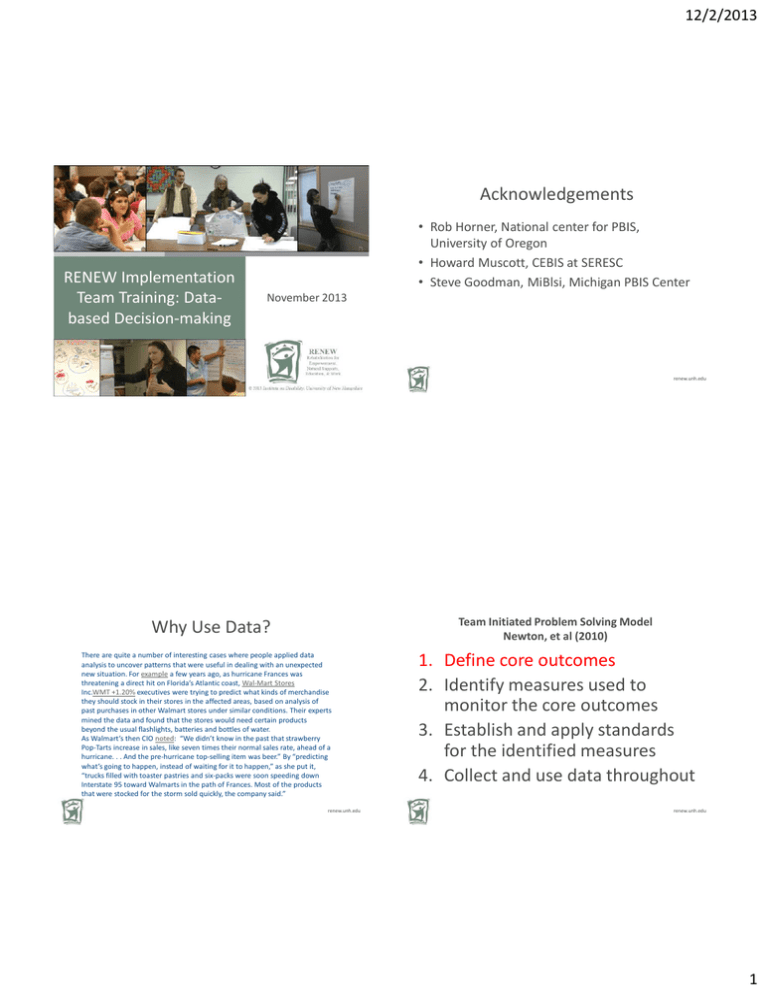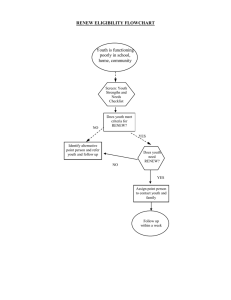Acknowledgements 12/2/2013 RENEW Implementation
advertisement

12/2/2013 Acknowledgements RENEW Implementation Team Training: Databased Decision-making • Rob Horner, National center for PBIS, University of Oregon • Howard Muscott, CEBIS at SERESC • Steve Goodman, MiBlsi, Michigan PBIS Center November 2013 renew.unh.edu renew.unh.edu Team Initiated Problem Solving Model Newton, et al (2010) Why Use Data? There are quite a number of interesting cases where people applied data analysis to uncover patterns that were useful in dealing with an unexpected new situation. For example a few years ago, as hurricane Frances was threatening a direct hit on Florida’s Atlantic coast, Wal-Mart Stores Inc.WMT +1.20% executives were trying to predict what kinds of merchandise they should stock in their stores in the affected areas, based on analysis of past purchases in other Walmart stores under similar conditions. Their experts mined the data and found that the stores would need certain products beyond the usual flashlights, batteries and bottles of water. As Walmart’s then CIO noted: “We didn’t know in the past that strawberry Pop-Tarts increase in sales, like seven times their normal sales rate, ahead of a hurricane. . . And the pre-hurricane top-selling item was beer.” By “predicting what’s going to happen, instead of waiting for it to happen,” as she put it, “trucks filled with toaster pastries and six-packs were soon speeding down Interstate 95 toward Walmarts in the path of Frances. Most of the products that were stocked for the storm sold quickly, the company said.” renew.unh.edu 1. Define core outcomes 2. Identify measures used to monitor the core outcomes 3. Establish and apply standards for the identified measures 4. Collect and use data throughout renew.unh.edu 1 12/2/2013 Team Initiated Problem Solving Model Newton, et al (in press) Key Questions What are the goals you hope to achieve this year (in the context of RENEW)? How does accomplishment of these goals connect to your success as an agency/school? 1. Define core outcomes 2. Identify measures used to monitor the core outcomes 3. Establish and apply standards for the identified measures 4. Collect and use data throughout renew.unh.edu Begin with Broad Core Outcomes or Key Questions 1. What do you want to achieve in terms of RENEW implementation this year (broad core outcomes)? 2. Do you have past and/or current data (Valid) to know if you will be successful? Is it accurate? (Reliability) 3. If not, how can you get valid and reliable data? renew.unh.edu renew.unh.edu Key Features of Effective Data Systems 1. The data is used to answer important questions about outcomes 2. The data are accurate 3. The data are very easy to collect (1% of staff time) 4. The data are collected continuously 5. The data collection should be an embedded part of your agency/school data (not something “extra”) renew.unh.edu 2 12/2/2013 Key Features of Effective Data Systems 6. Data should be summarized prior to meetings of decision-makers (e.g. monthly) 7. Data are used for decision-making 1. The data must be available when decisions need to be made 2. The people who collect the data must see the information used for decision-making 8. The data are used to celebrate success renew.unh.edu renew.unh.edu RENEW Data Examples: Are Youth Making Progress? RENEW Data Examples % Credits Earned/Credits Enrolled (n=24) Average Unexcused Absences /Semester n=21 Average ODRS/Semester (n=25) 6 1.4 0.6 20.00 5 1.2 0.5 16.00 14.00 3 Average No. of OSS/Semester 18.00 4 0.4 12.00 10.00 2 0.3 8.00 0.2 6.00 1 Out of School Suspensions per Semester (n=25) 0.7 4.00 1 0.8 0.6 0.4 0.2 0.1 2.00 0 1 2 3 0 0.00 0 1 2 3 1 1 renew.unh.edu 2 3 2 3 Semester renew.unh.edu 3 12/2/2013 RENEW Data Examples Goals Met Youth with Teams 60% 18% 16% 14% 12% 10% 8% 6% 4% 2% 0% 54.00 % Jobs Obtained Graduated/GED 60% 16.00 % 11.54 % 54.00 % 50% 38.46 % 40% 30% 20% 10% 50% 20% 0% 38.46 % 26.23 % 40% 44.26% 10% 0% 0% RENEWI RENEWII RENEWIII renew.unh.edu 70.51% 60% 50% 20% 10% RENEWIII 86.00% 70% 30% RENEWI RENEWII RENEWIII RENEWII 90% 80% 40% 30% 18.03 % 100% RENEWI RENEWII RENEWIII renew.unh.edu 4

